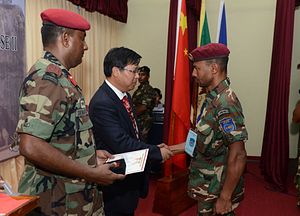China and Sri Lanka concluded their second-ever joint military exercise last week. Exercise Silk Route 2015, likely named so for its concordance with China’s Maritime Silk Road initiative, in which Sri Lanka is a partner, incorporated a 43-member Chinese People’s Liberation Army contingent and soldiers from the Sri Lankan army. According to a statement released by the Sri Lankan Ministry of Defense, the Sri Lankan Army’s Commando Regiment and Special Forces participated in the exercises, which ran from June 22 to July 13, 2015. The exercise demonstrates the continuing deepening of security ties between Beijing and Colombo, despite the election of a new government in Sri Lanka in January which appeared to be less receptive to Chinese influence on the island that the previous government, which was led by Mahinda Rajapaksa.
The Ministry’s statement noted a focus on primarily tactical exercises, including on “weapon handling, VVIP protection study, live firing, lane firing, sniper firing, body protection drills, backup vehicle movement and training, body protection formation, ambush drills, reconnaissance techniques, skill firing, special mission planning, combat tracking techniques, situation training exercise, jungle warfare and basic battle skills, vehicle ambush drills, aircraft and building option training, etc.”
China’s growing relationship with Sri Lanka has caused concern in New Delhi, which perceives any Chinese military activity in the Indian Ocean Region (IOR) as a prelude to encirclement. When Maithripala Sirisena came to power in a surprise election victory over Rajapaksa, it appeared that Sri Lanka may reevaluate its relationship with China. Sirisena’s campaign manifesto contained some particularly damning passages toward China, including one where he criticized the previous government’s handling of contracts that were awarded to Chinese firms: “The land that the White Man took over by means of military strength is now being obtained by foreigners by paying ransom to a handful of persons,” his manifesto noted.
In his first six months in office, however, Sirisena has remained cordial with Beijing, despite freezing some development projects and reviewing contracts awarded by the previous government. In fact, as Silk Route 2015 came to a close, reports emerged that Sri Lanka was actively looking to substitute Chinese funding and investment with other sources. This development would mesh with another statement Sirisena had made on foreign policy in his election manifesto. He noted a desire to have balanced and well-diversified foreign relations: “Equal relations will be established with India, China, Pakistan and Japan — the principal countries of Asia while improving friendly relations with emerging Asian nations such as Thailand, Indonesia, and Korea without distinction.”
The current reality of Sri Lanka-China relations is, of course, somewhere between abandonment and a complete pivot from Colombo’s side. The Sirisena government is also overseeing a potential period of great political change domestically in Sri Lanka, including reform that could lead to a return for Mahinda Rajapaksa as prime minister–a position that has been strengthened under recent reforms by the Sirisena government. Should Rajapaksa return to the fore in Sri Lankan politics, expect things to pick up with China.

































